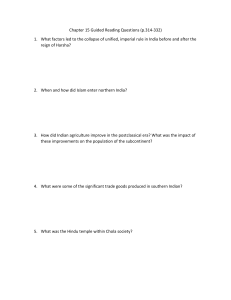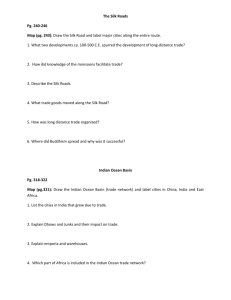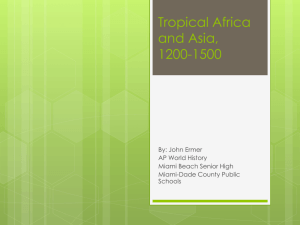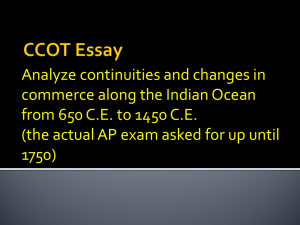600-1450 CE Changes & Continuities Timeline
advertisement
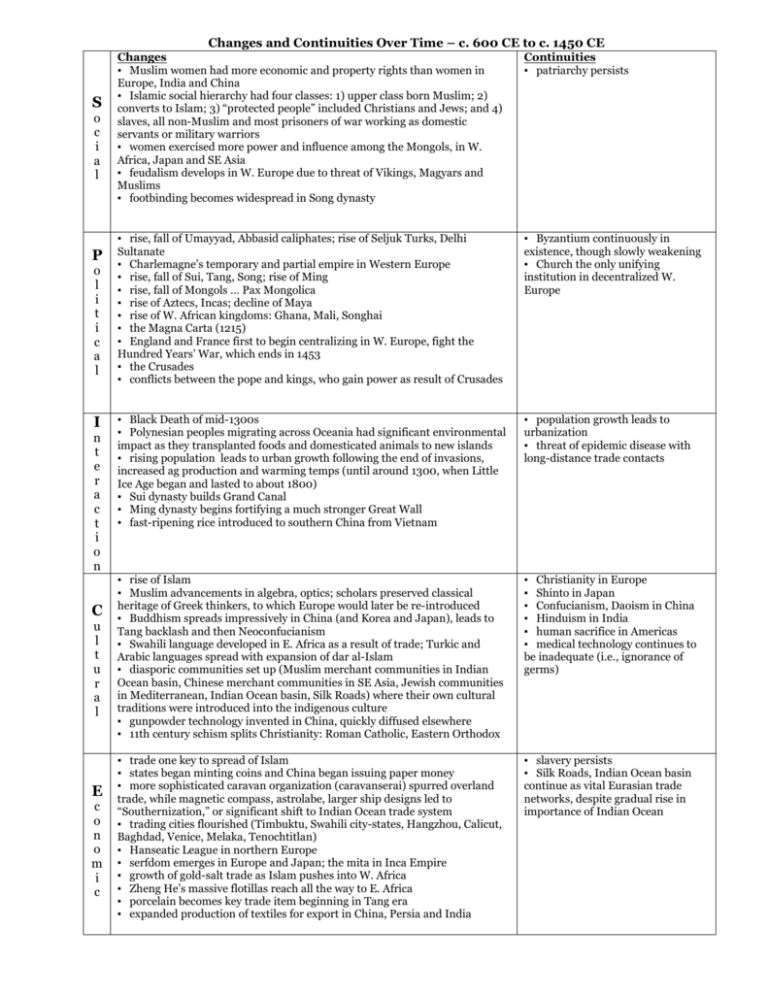
Changes and Continuities Over Time – c. 600 CE to c. 1450 CE S o c i a l P o l i t i c a l I n t e r a c t i o n C u l t u r a l E c o n o m i c Changes ▪ Muslim women had more economic and property rights than women in Europe, India and China ▪ Islamic social hierarchy had four classes: 1) upper class born Muslim; 2) converts to Islam; 3) “protected people” included Christians and Jews; and 4) slaves, all non-Muslim and most prisoners of war working as domestic servants or military warriors ▪ women exercised more power and influence among the Mongols, in W. Africa, Japan and SE Asia ▪ feudalism develops in W. Europe due to threat of Vikings, Magyars and Muslims ▪ footbinding becomes widespread in Song dynasty Continuities ▪ patriarchy persists ▪ rise, fall of Umayyad, Abbasid caliphates; rise of Seljuk Turks, Delhi Sultanate ▪ Charlemagne’s temporary and partial empire in Western Europe ▪ rise, fall of Sui, Tang, Song; rise of Ming ▪ rise, fall of Mongols … Pax Mongolica ▪ rise of Aztecs, Incas; decline of Maya ▪ rise of W. African kingdoms: Ghana, Mali, Songhai ▪ the Magna Carta (1215) ▪ England and France first to begin centralizing in W. Europe, fight the Hundred Years’ War, which ends in 1453 ▪ the Crusades ▪ conflicts between the pope and kings, who gain power as result of Crusades ▪ Byzantium continuously in existence, though slowly weakening ▪ Church the only unifying institution in decentralized W. Europe ▪ Black Death of mid-1300s ▪ Polynesian peoples migrating across Oceania had significant environmental impact as they transplanted foods and domesticated animals to new islands ▪ rising population leads to urban growth following the end of invasions, increased ag production and warming temps (until around 1300, when Little Ice Age began and lasted to about 1800) ▪ Sui dynasty builds Grand Canal ▪ Ming dynasty begins fortifying a much stronger Great Wall ▪ fast-ripening rice introduced to southern China from Vietnam ▪ population growth leads to urbanization ▪ threat of epidemic disease with long-distance trade contacts ▪ rise of Islam ▪ Muslim advancements in algebra, optics; scholars preserved classical heritage of Greek thinkers, to which Europe would later be re-introduced ▪ Buddhism spreads impressively in China (and Korea and Japan), leads to Tang backlash and then Neoconfucianism ▪ Swahili language developed in E. Africa as a result of trade; Turkic and Arabic languages spread with expansion of dar al-Islam ▪ diasporic communities set up (Muslim merchant communities in Indian Ocean basin, Chinese merchant communities in SE Asia, Jewish communities in Mediterranean, Indian Ocean basin, Silk Roads) where their own cultural traditions were introduced into the indigenous culture ▪ gunpowder technology invented in China, quickly diffused elsewhere ▪ 11th century schism splits Christianity: Roman Catholic, Eastern Orthodox ▪ Christianity in Europe ▪ Shinto in Japan ▪ Confucianism, Daoism in China ▪ Hinduism in India ▪ human sacrifice in Americas ▪ medical technology continues to be inadequate (i.e., ignorance of germs) ▪ trade one key to spread of Islam ▪ states began minting coins and China began issuing paper money ▪ more sophisticated caravan organization (caravanserai) spurred overland trade, while magnetic compass, astrolabe, larger ship designs led to “Southernization,” or significant shift to Indian Ocean trade system ▪ trading cities flourished (Timbuktu, Swahili city-states, Hangzhou, Calicut, Baghdad, Venice, Melaka, Tenochtitlan) ▪ Hanseatic League in northern Europe ▪ serfdom emerges in Europe and Japan; the mita in Inca Empire ▪ growth of gold-salt trade as Islam pushes into W. Africa ▪ Zheng He’s massive flotillas reach all the way to E. Africa ▪ porcelain becomes key trade item beginning in Tang era ▪ expanded production of textiles for export in China, Persia and India ▪ slavery persists ▪ Silk Roads, Indian Ocean basin continue as vital Eurasian trade networks, despite gradual rise in importance of Indian Ocean
